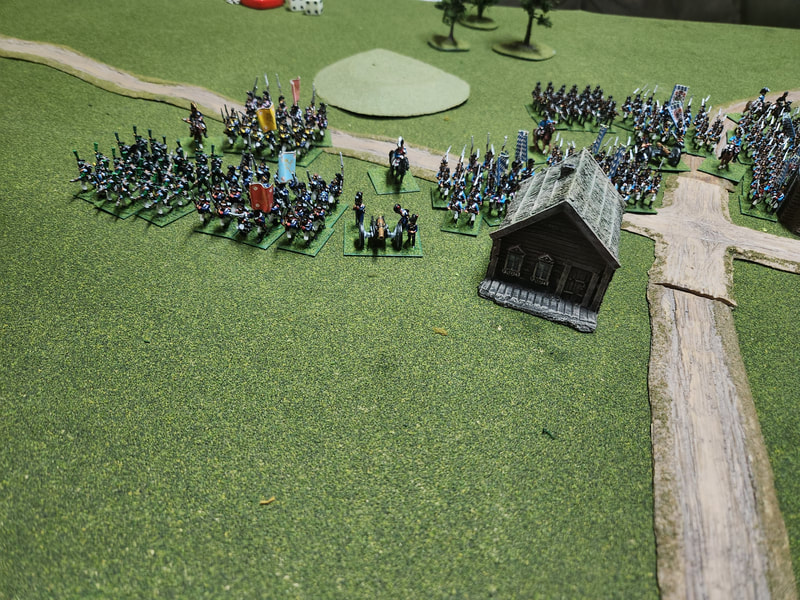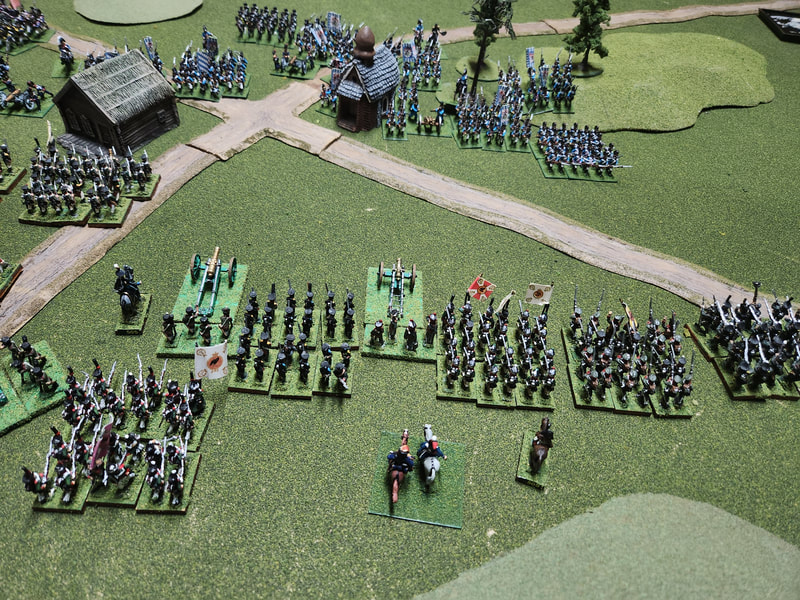|
Forward Somewhere on the Austrian-Russian border there are two small villages, Opol and Cheniye. The former has a spectacular onion-domes church while the latter has a cruder, board and thatch affair. Late in the campaign season of 1809, while Napoleon threatened Vienna and was on the verge of the great victory of Wagram, Russian Emperor Alexander hesitatingly decided to make an effort to the aid the Austrians. Napoleon, thinking Alexander much too vacillating, had only detached some German allies to cover the approached from Mother Russia. This Corps d’Observation was also hesitant to come to battle but, on the fateful 1st of July, the two reluctant forces collided with a violence that belied their rather tepid performance up until that time. Forces The Russian Relief was under the overall command of General Pyotr Bagratian. Under his immediate command were his own VI Corps and Lieutenant General Kapzevitch and his X Corps. Each corps had two divisions, and each division had two line brigades, a brigade of jagers, and a heavy battery of 12-pounders. In addition, Hetman Akim Karpov brought 8 sotnias of Cossacks; 3 from the Bug and 5 from the Don. Marshal Francois Lefebvre commanded the Corps d’Observation. This contained three divisions of Bavarians, a division of Wurttemburgers, and a mixed division of two light cavalry brigades, one from each German state. The Marshal kept two 12-pounder batteries and a pair of horse batteries in reserve. The two groups were evenly matched. Although the Russians had 48 guns to the Germans’ 32 and a couple hundred more infantry, the Germans had cavalry unafraid to mix it up in close combat and a higher percentage of veterans. Foils Bagratian had promised some of his generals that they could ride to Opol on the morning of the 1st to worship in the church whose dome they could see when they camped for the night. October 1 was a Sunday and they looked forward to services, and, perhaps, to the generosity of the congregation to fill their lunchtime tables with something a little above the normal campaign fare. However, when Major Generals Grekov, Vasiltschikov, and Doctorov rode into town they were appalled to see dust to the north, where no Russian troops should have been. Several ADCs rode out and returned to report the column on the road was Bavarian. With that, the generals gave up on both religious services and lunch and hurried back to the Russian camp to raise the alarm. Why were the Bavarians on the march? Prinz Ludwig’s division had spent a dry Saturday marching back and forth, chasing phantom Russian columns. Lefebvre had ordered the cavalry to conserve their mounts and therefore could only guess where Bagratian’s column, rumored to be nearby, actually was. The Prince had also seen the onion dome as his troops laid down that Saturday evening. He assumed, where there was a church there was sure to be water and had obtained permission to get his men a drink after breakfast. Falling To Lefebvre’s troops marched out smartly and soon Prinz Ludwig had Prinz Karl’s brigade in Opol with his other two brigades in support – holding the wood to the east and holding Graf Ypenburg in support. Major General von Seydenitz deployed on a low hill to the east of Ludwig. (203215) Simultaneously, General von Wrede had brough up his mixed division to the west, throwing Major General Maranitz’s brigade into Cheniye and extending the line to the west with the rest of Major General Preysing’s division, then General Neubronn’s division of Wurttemburgers on the extreme right of the German infantry line. (left photo) A wooded hill on the far west became the focus of both cavalry groups. Hetman Karpov though his troopers would be relatively safe and able to swoop over the battlefield from their perch at the opportune time, while Major General Deroi trotted out (his horses were fresh as they had not been used the day before in screening or scouting) seeking to vanquish a foe he thought to be Russian Uhlans. Bagratian advanced his infantry to match Lefebvre’s deployment, with the VI Corps on the west opposite Wrede and the X Corps opposite Prinz Ludwig and General von Seydenitz. (right photo) The Germans, at all points, won the march to the terrain points. Deroi reaching the hill first and ascending through a gap in the trees; Wrede reaching the road from Cheniye, and Ludwig and Seydenitz reaching Opol and the eastern hill, before any Russian was in artillery range. Far Flank Karpov had not anticipated the necessity to fight formed troops and, as such, the Don Cossacks were still in column of division when Deroi crested the hill with his brigade of Wurttemberg Chevauxleger leading and the Bavarians in support. In the heat of the moment the Wurttembergers charged headlong into the irregulars. However, unreadiness, conversely, can work to one’s advantage. Such was the case as the bewildered chevauxlegers scattered one group of lancers after another only to find more obstructing their way. Deroi called on his men to reform. Only then did he see the Bug Cossacks forming on his right. The Bavarian general urged his troops forward to meet the Russian irregulars at the southern foot of the hill. As irregulars are wont to do, the men from the Bug gave some ground but regrouped just outside the lunge of the saber-armed Germans. Deroi had deployed his horse battery on his left and they took some shots at Vasiltschikov’s men as they marched past but caused only minor irritation. Again, the Wurttembergers dashed at the Don Cossacks. Again, the men from the steppe recoiled and reformed like the waters of the Don in flood. Deroi, conscious of events on the infantry line, ordered Duke Louis to continue the effort to rout the elusive irregulars while he decamped with the Bavarians and horse guns to help the hard-pressed footmen (see below). Louis, outnumbered two to one, finally came to grips with his foe, embracing the Bug sotnias in a brief death duel with his own regiment. Many saddles were emptied, and the surviving Bug troopers “bugged” out, racing 800 meters to the rear before turning to face their tormentors. But Louis had recalled his regiment to face the Don sotnias, now reorganized and led personally by Karpov. For the fifth time that morning the Wurttembergers charged and met their opponents from the far grasslands. For the fourth time the Cossacks swirled away relatively unharmed. Louis regrouped only to receive a lathered messenger from Deroi – the battle was lost, time to pull out. Despite all the charging back and forth, total casualties for Karpov’s men were only 87. Louis’ brigade suffered even less - 11 men wounded, 2 killed, and 25 missing. Most of the latter showed up at camp, red-faced, the next evening. Footfalls Bagratian now used the stoicism of the Russian infantry to the fullest. Having been denied the terrain features by the more rapid marching of the Germans, Bagratian simply failed to send his corps orders to halt. His columns, dutifully, continued to march directly at the enemy. On the Russian left Kadyschev’s line brigade pitched into the Wurttemburg light brigade who gave way. Simultaneously, Glebov’s jagers charged Herzog Wilhelm’s regiment and forced it to retreat. Baron von Neubronn immediately galloped to rally the shocked infantry regiments while General Wrede called for reinforcements. Kadyschev now pitched into Prinz Paul’s regiment, but the Prinz’s men only bent. Glebov’s victorious jagers now rushed over the Wurttemburg reserve battery, scattering the gunners. Paul’s resistance and the disorganization inherent in capturing the battery allowed von Neubronn and Wrede the time they needed. The Bavarian light infantry rallied forward from their initial position behind Cheniye, forced Glebov to give ground. With the Bavarian Kronprinz regiment repositioning to support, the German right seemed to be stabilizing. However, to be sure, Wrede sent an aide galloping to see if Deroi could offer help; this was the recall of the Bavarian chevauxleger. Brigadier Glebov now led his reserve battalion forward. Their inexorable advance broke the resolve of the Bavarian light brigade and carried forward into Kronprinz, pushing the latter back. Kadyschev continued to press Prinz Paul. Coming up on the left, Panzerbiter’s brigade moved to counter Deroi’s arrival. The latter, responding to Wrede’s call, had deployed his horse artillery forward and the Bavarian chevauxleger, having squeezed through the gap in the trees, coming up. Panzerbiter charged the guns and overran them. Deroi called for his sabers to recover the guns. The Russians hastily formed square and repelled the cavalrymen, though they had to relinquish four of the six guns, which were hastily withdrawn. Neubronn and Wrede (and Deroi) had bent but they had not broken. However, their situation was precarious, their artillery lost, their troops shaken, and fresh Russian brigades near at hand. They were relieved when orders arrived from Lefebvre to fall back. They’d find water somewhere else. Fencing
Lieutenant General Kapzevitch was more cautious than his chief and, therefore the battle on the eastern half of the field was initiated by the Bavarians. General Seydenitz, being originally a cavalryman, was not one to sit on a height and endure bombardment. He launched his Provisional Brigade - made up of a garrison battalion, a depot battalion, and three Grenzer companies – and the Konig Regiment against the Russian right flank, Doctorov’s division. The Provisionals, having borne the brunt of camp jokes since joining the corps, had a lot to prove and they drove Voyeikov’s jagers back. Konig, however, faltered. Lyapunov’s brigade had their blood up and checked the Bavarian assault and then counterattacked, sending them flying. Lyapunov carried forward and pitched into the Regiment von Preysing. Kniazin’s brigade came up in support and Doctorov’s batteries shook Prinz Karl’s regiment with deadly fire, even as the Bavarians huddled in the cover of the buildings in Opol. Regiment von Preysing, after a desperate struggle with Lyapunov, fell back and rallied on the rise on the left of the German line. But Lefebvre had no more troops. With all the Wurttemburg guns captured or in flight, Bagratian redeployed a third battery in front of Opol, making 36 heavy guns against only 14 Bavarians. This weight of metal on his center, with casualties mounting and both flanks held by rattled regiments, Lefebvre gave the orders to withdraw. The Provisionals were recalled, but were unable to rejoin the line, having the brigades of Kniazin and Lyapunov interposed and had a long march to regain Lefebvre. Finale Bagratian let Lefebvre go. Deroi’s troopers threatened any impetuous motion of the infantry, and the well water was a strong draw to the parched throats of the infantry. Vasiltschikov lamented to his chief that a single regiment of regular cavalry would have granted them a crushing victory. Bagratian nodded, saying “If only does not win the battle. We have done enough.” In truth, the Russian infantry had done very well. At a cost of 956 casualties, they had captured 10 guns and inflicted 1813 casualties on the German infantry. Except for the Provisional Brigade, which drove Voyeikov’s brigade completely out of line, no German infantry formation was worthy of exceptional mention. Bagratian, in his report to Emperor Alexander, made no mention of Hetman Karpov’s performance except to say he was engaged on the left. He did, however, single out Brigadiers Lyapunov, Kadyschev, and Glebov for their gallantry and success. Only a few days later came the crushing defeat of the Austrians at Wagram and their collapse. With Napoleon’s victory, the Emperor recalled Bagratian.
0 Comments
Leave a Reply. |
AuthorDiatribes are simply often humorous recountings of the games played by the Long Island Irregulars. We play with toy soldiers and are unabashedly happy to have never lost this part of our childhoods.. Archives
April 2024
Categories
All
|


 RSS Feed
RSS Feed